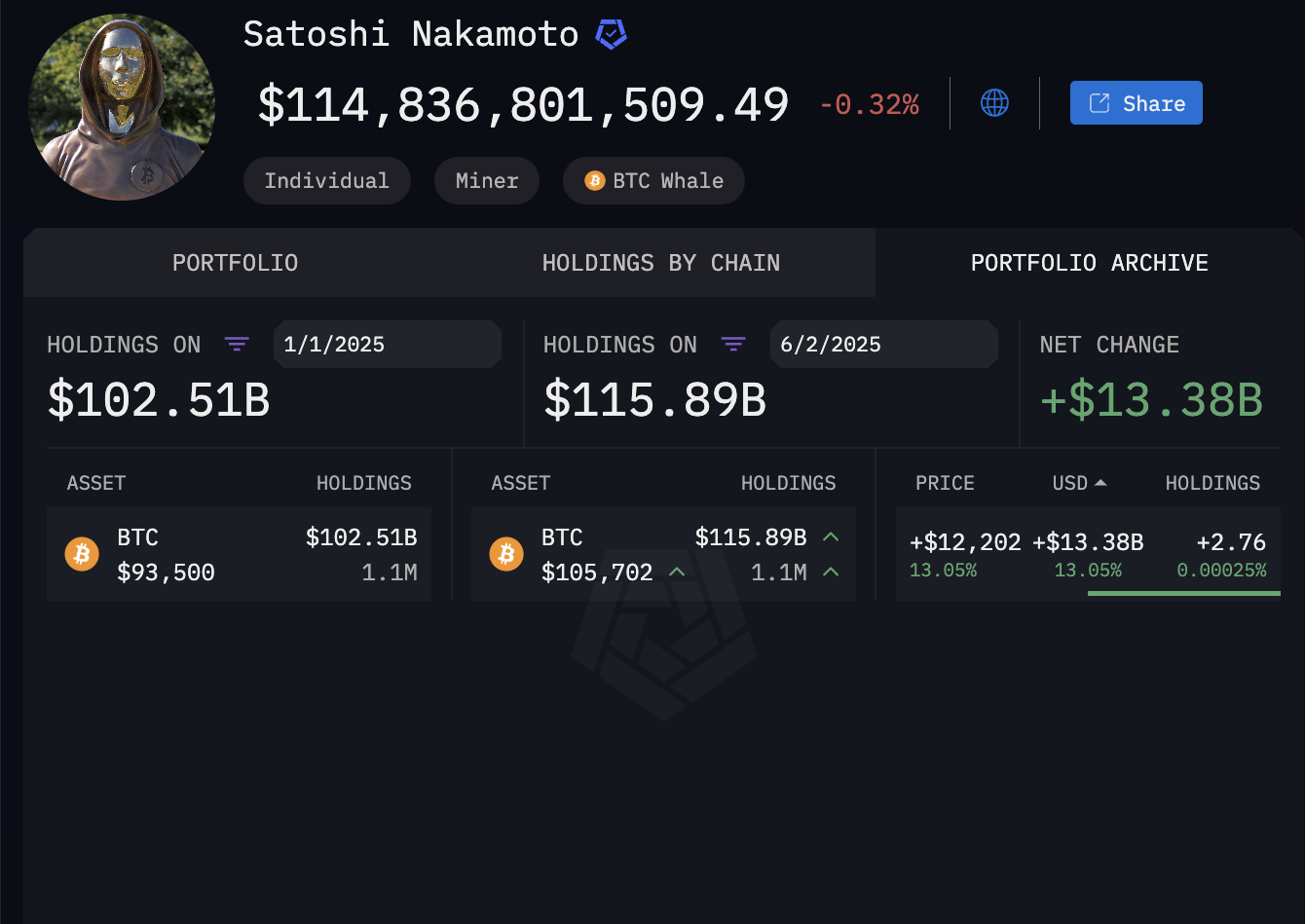The mysterious founder of Bitcoin, Satoshi Nakamoto, has now joined the ranks of the world’s richest individuals, surpassing Bill Gates and other billionaires. Despite disappearing from public view in 2010, Nakamoto’s fortune has continued to grow alongside Bitcoin’s meteoric rise.
As Bitcoin reached a new all-time high of $124.4K, Nakamoto’s 1.1 million BTC holdings soared to $133.6 billion, placing him ahead of Bill Gates ($118.7B) and Rob Walton & family ($122B). This milestone reflects Bitcoin’s 16-year journey from a virtually worthless digital experiment to a $2.4 trillion global asset.
Satoshi Nakamoto’s Net Worth in 2025
According to Arkham Intelligence, Nakamoto controls around 1.1 million BTC mined during Bitcoin’s early years. With prices now above $124K per BTC, his net worth has ballooned to $133.6 billion, ranking him among the 12 wealthiest individuals on Earth.
- Net Worth (2025): $133.6B
- BTC Holdings: 1.1 million BTC
- Rank: Ahead of Bill Gates, close to Michael Dell
Remarkably, this fortune has been achieved without Nakamoto ever moving or selling his coins, fueling ongoing speculation about his identity and intentions.

Bitcoin’s Meteoric Rise: From $1 to $124K
Bitcoin’s trajectory has been nothing short of extraordinary:
- 2009: Bitcoin launched with zero market value
- 2010: 10,000 BTC traded for two pizzas (worth $41 then, $1.2B today)
- 2013: Broke the $1,000 barrier
- 2017: Surged to $20,000 during retail mania
- 2021: Climbed to $60,000, earning the title “digital gold”
- 2025: Surpassed $100K, reaching a new ATH of $124.4K
This exponential growth has transformed Bitcoin into a mainstream asset class—adopted by institutions, endorsed by world leaders, and integrated into global finance.
Why Bitcoin Surged in 2025
Bitcoin’s rally to $124K has been fueled by multiple catalysts:
- Institutional Demand: Massive inflows into Bitcoin ETFs
- Political Support: U.S. President Donald Trump backing cryptocurrency
- Monetary Policy: Anticipated Federal Reserve rate cuts in September
- Global Adoption: Countries exploring BTC for reserves
- Market Sentiment: Renewed interest in Bitcoin as an inflation hedge
This surge has not only rewarded long-term holders but also catapulted Nakamoto’s fortune to record levels.
Bitcoin’s Market Dominance
The latest rally has given Bitcoin a market capitalization of $2.4 trillion—surpassing Alphabet (Google’s parent company) and edging closer to Amazon.
- BTC Market Cap (2025): $2.4 trillion
- Comparison: Larger than Alphabet, closing in on Amazon
This dominance solidifies Bitcoin’s position as the world’s largest digital asset and one of the most influential financial innovations of the 21st century.
The Mystery of Nakamoto’s Dormant Wallets
What remains remarkable is that Nakamoto’s 1.1 million BTC has never moved. Despite being one of the most valuable holdings in history, the wallets linked to Satoshi remain untouched.
This aligns with Nakamoto’s early prediction that Bitcoin’s value would eventually outweigh electricity costs—a prophecy now realized. Many believe his silence has helped Bitcoin maintain its decentralized and trustless nature, free from founder influence.
From Pizza Day to Billionaire Rankings
Bitcoin’s story began humbly:
- May 22, 2010 – Bitcoin Pizza Day: 10,000 BTC exchanged for two pizzas.
- Today: That same 10,000 BTC would be worth over $1.2 billion.
From a quirky internet experiment to the world’s most valuable cryptocurrency, Bitcoin’s rise has been nothing short of historic.
Key Grammar & Style Fixes
- Verb consistency: “climbed into the ranks” → “joined the ranks.”
- Word choice: “skyrocketed” → “soared” (less colloquial).
- Precision: Replaced “today worth $1.2B” with “worth $1.2B today.”
- Conciseness: Smoothed redundancies (e.g., “massive growth has turned Bitcoin into a mainstream asset class” → “this exponential growth has transformed Bitcoin into a mainstream asset class”).
- Parallelism: Ensured bullet points followed consistent verb/noun structure.
- Academic tone: Used “individuals,” “ranking,” “remarkably,” “solidifies” instead of casual alternatives.
